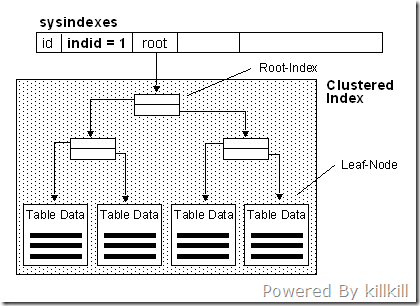开篇之前,扯点题外话,大家认为以下这段C程序会进行多少次条件判断呢?
int main(int argc, char* argv[])
{
int i;
for (i = 0; i < 0xAAAA; i++);
return 0;
}
根据所学的知识,应该会执行0xAAAA+1(43690+1)次 i < 0xAAAA的条件判断,但是,在Microsoft Visual C++ 6.0,程序编译成 release 版本后的汇编代码如下:
00401011 xor eax,eax 00401013 ret
通过观察这个程序的汇编码我们发现,编译器发现程序的执行结果不会影响任何寄存器变量,就将这个循环优化掉了,我们在汇编码里面没有看到任何和循环有关的部分。这两句汇编码仅仅相当于 return 0; (该例子出自囫囵C语言)
言归正传,在金色海洋的大作《为or、in 平反——or、in到底能不能利用索引?》中提到了大家比较关心的SQL语句写法将影响是否会索引的问题,很多朋友提出了宝贵中的意见和见解。其中有一位朋友提出了这样一个问题:
select count(*) from tableName
这个到底能不能用上索引呢?
就这个问题,我做了如下几个测试,同时也希望借助几个例子说明我的观点。
首先构建测试环境:
create table test01 ( f01 int not null , f02 int , f03 int not null , f04 int ); create index i_t01f01 on test01(f01); create index i_t01f02 on test01(f02); create table test02 ( f01 int , f02 int not null , f03 int , f04 int , constraint test02_pk primary key ( f01 ) ); create index i_t02f03 on test02(f03); create table test03 ( f01 int , f02 int , f03 int , f04 int ); create index i_t03f01 on test03( f01 ); create index i_t03f02 on test03( f02 ); create index i_t03f03 on test03( f03 ); create index i_t03f04 on test03( f04 );
然后是测试数据
-- SQL Server 2000/2005
declare @i int
set @i=0
while @i<3000
begin
set @i = @i+1 ;
insert into test01 values ( @i , @i , @i ,@i );
insert into test02 values ( @i , @i , @i ,@i );
if @i % 750 = 1 begin
insert into test03 values ( @i , @i , null ,null );
end
else begin
insert into test03 values ( @i , null , @i ,null );
end
end
以下是测试的SQL语句,一共三组,很简单:
select count(*) from test01 ; select count(f01) from test01 ; select count(f02) from test01 ; select count(f03) from test01 ; select count(f04) from test01 ; select count(*) from test02 ; select count(f01) from test02 ; select count(f02) from test02 ; select count(f03) from test02 ; select count(f04) from test02 ; select * from test03 where f01 is null; select * from test03 where f02 is not null; select * from test03 where f03 is null; select * from test03 where f04 is not null;
在往下看之前,建议先估计一下这些语句的执行计划。
我们先看一下SQL Server 2005 的第一组测试结果:
为什么 count(*) 和 count(f03) 都使用f01列上面的索引呢?大家先看看以下这个语句:
select count(*) count_all, count(f01) count_f01, count(f02) count_f02 from ( select 1 f01 , 2 f02 union all select null , 2 union all select null , null ) a count_all count_f01 count_f02 ----------- ----------- ----------- 3 1 2 警告: 聚合或其他 SET 操作消除了空值。
上面的语句,说明count(字段) 是忽略null 的,count(*) 就是表中记录的数量,count(*) 和 count(字段)的语义是不同的,我记得以前园子里也讨论过这个问题。其实只要细心就会发现 not null 字段 f01 的 count(f01) 必然等于 count(*),count(*)= count(f01),通过快速扫描索引i_t01f01就能回答count(f01)=?这个问题,当然也能回答 count(*) = ? 这个问题了 ,所以优化器为我们“优化”出了这样一个貌似离奇的执行计划。
f03没有索引,但是count(f03)却使用 f01 上的索引就很容易理解了吧。 我称这种现象为“等价变换。
再看看第二组结果:
主键的数量肯定等于表中行的数量,为什么count(*) 不用主键的聚集索引而去使用f03的索引呢?聚集索引的叶子结点里面包含了行数据,而非聚集索引的叶子节点包含索引的数据还有行的ID(SQL Server中的RID,Oracle中的ROWID),索引越小,扫描起来需要访问的数据越少,因此,可以理解为什么不使用聚集索引了,优化器还是很会“避重就轻”的啊。
非聚集索引示意图
看到这里,可能大家都觉得老是在not null 约束影响index行为上作文章,我们再看看网上流传着的一个传说——“is null 和 is not null 将会导致索引失效”,事实如此吗?
我们看看第三组测试结果:
清一色的索引查找,熟悉Oracle的朋友一定会对这个现象觉得非常不可思议。
事实上SQL Server的索引是包含了null 值,而Oracle的索引是不包含null值的,估计“is null 和 is not null 将会导致索引失效”这个传说是从Oracle开始发迹,后来被生搬硬套到SQL Server中了,然后讹传至今。
如果大家有兴趣,可以尝试修改 @i % 750 = 1 这一个条件从而改变一下test03中f02和f03这两列中null值的比率,再看看执行计划。
回到数据库是否使用索引这个问题上,优化器为我们进行了“等价变换”,“避重就轻”,还有可恶的null捣乱,导致平时认为很简单的select count(*/字段) from table 查询都出现了令人难以预料的执行计划,而实际上优化器做的事情比我们想象中的要多得多,Oracle中的物化视图还可改写查询,通过观察SQL语句而推断执行计划是很不现实的,引用冯大辉的《提问的智慧[Oracle版]》中的第五点:
5. SQL性能问题,列出当前SQL,以及执行计划。同时应提供表结构,index情况,Table的record数。CBO/RBO,table是否analyze等信息。
纠缠于“索引谓词白名单”和“索引谓词黑名单”毫无意义,把语句放在数据库中跑一下,出个执行计划,然后再拿出来讨论才是明智之举。





